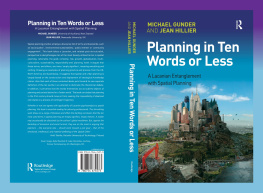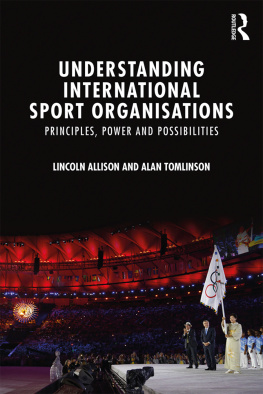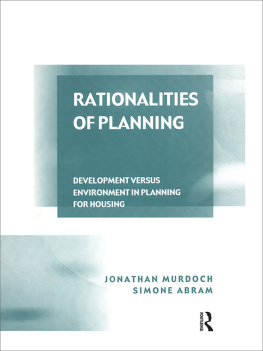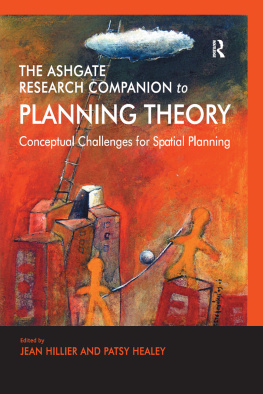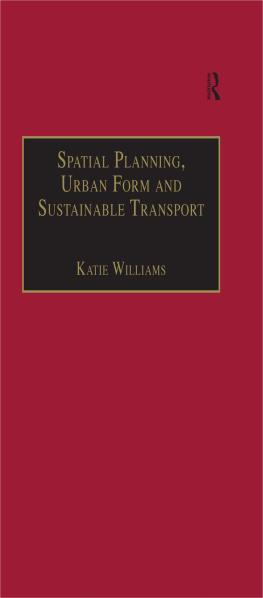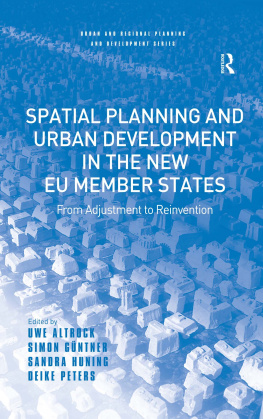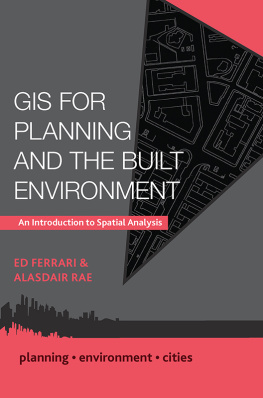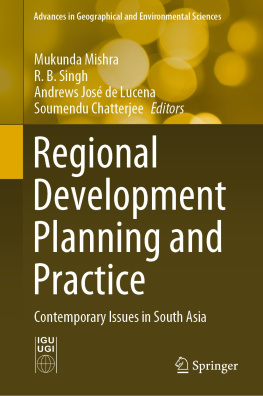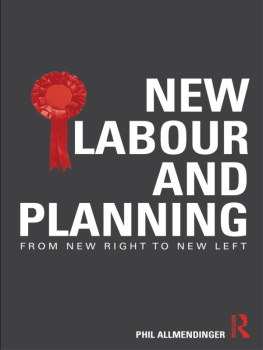PLANNING IN TEN WORDS OR LESS
For Adriana
First published 2009 by Ashgate Publishing
Published 2016 by Routledge
2 Park Square, Milton Park, Abingdon, Oxon OX14 4RN
711 Third Avenue, New York, NY 10017, USA
Routledge is an imprint of the Taylor & Francis Group, an informa business
Copyright Michael Gunder and Jean Hillier 2009
Michael Gunder and Jean Hillier have asserted their rights under the Copyright, Designs and Patents Act, 1988, to be identified as the authors of this work.
All rights reserved. No part of this book may be reprinted or reproduced or utilised in any form or by any electronic, mechanical, or other means, now known or hereafter invented, including photocopying and recording, or in any information storage or retrieval system, without permission in writing from the publishers.
Notice:
Product or corporate names may be trademarks or registered trademarks, and are used only for identification and explanation without intent to infringe.
British Library Cataloguing in Publication Data
Gunder, M. (Michael)
Planning in ten words or less : a Lacanian entanglement
with spatial planning.
1. City planning--Philosophy.
I. Title II. Hillier, Jean.
307.1'2'01-dc22
Library of Congress Cataloging-in-Publication Data
Gunder, M. (Michael)
Planning in ten words or less : a Lacanian entanglement with spatial planning / by Michael Gunder and Jean Hillier.
p. cm.
Includes bibliographical references and index.
ISBN 978-0-7546-7457-3
1. City planning. 2. Regional planning. 3. Geographical perception. 4. Space perception. 5. Lacan, Jacques, 1901-1981. 6. Psychoanalysis. I. Hillier, Jean. II. Title.
HT166.G859 2009
307.1'2'01--dc22
2009005300
ISBN 9780754674573 (hbk)
Transfered to Digital Printing in 2013
Previously published works have been drawn on to partially produce this text. In all cases prior publications have significantly been revised and undated, in several cases whole papers largely form the basis of a discrete chapter in this work. Other articles have been pulled apart, deconstructed and re-territorialised in a manner constituting a jigsaw throughout these and the other various chapters. Published works drawn upon and reprinted with permission of the publisher include: Gunder, M. (2003) Passionate Planning for the Others Desire: An Agonistic Response to the Dark Side of Planning, Progress in Planning 60:3, 236-319; Gunder, M. (2003) Planning Policy Formulation from a Lacanian Perspective, International Planning Studies 8:4, 279-294; Gunder, M. (2004) Shaping the Planners Ego-Ideal: A Lacanian Interpretation of Planning Education, Journal of Planning Education and Research 23:3, 299-311; Gunder, M. (2005) Lacan, Planning and Urban Policy Formation, Urban Policy and Research 23:1, 91-111; Gunder, M. (2005) The Production of Desirous Space: Mere Fantasies of the Utopian City? Planning Theory 4:2, 173-199; Gunder, M. (2005) Obscuring Difference Through Shaping Debate: A Lacanian View of Planning for Diversity, International Planning Studies 10:2, 83-103 (); Hillier, J., Gunder, M. (2003) Planning Fantasies? An Exploration of a Potential Lacanian Framework for Understanding Development Assessment Planning, Planning Theory 2:3, 225-248; Hillier, J., Gunder, M. (2005) Not Over Your Dead Bodies! A Lacanian Interpretation of Planning Discourse and Practice, Environment and Planning: A 37:6, 1049-1066.
Chapter 1
Planning as an Empty Signifier
Political language is designed to make lies sound truthful and murder respectable, and to give an appearance of solidity to pure wind.
George Orwell, Politics and the English Language, cited in Watson 2004, 1
Cities are places of contested desire. Some of these strands of aspiration and hope are shaped and channelled into collective action for a better tomorrow through the deployment of techno-political narratives which strive to signify potentially better futures. These spatial planning narratives and the words that summarise and label them are largely predicated on the implication that something in the present is lacking or incomplete. The city would be better, if only
Spatial planning practice performs a dialogue between planning and urban governance that is full of signifying terms and labelling buzzwords, or weasel words as Watson (2004) terms them, many of which imply innovative means to achieve desired states of urban well-being, such as deploying Smart Growth, new urbanism or bohemian indexes to plan for sustainable, globally competitive, and liveable cities. We argue that these terms, and many others, are mere empty signifiers, meaning everything and nothing comfort terms all things to all people. These desirous states of living and being, which most of us would aspire towards and, accordingly, attempt to shape our cities to achieve, are often illusions, attained, at best, with limited success.
In this book we demythologise ten of the most heavily utilised terms in the spatial planning literature and practice: certainty, the good, risk, growth, globalisation, multiculturalism, sustainability, responsibility, rationality and planning itself. Our analytical debunking frame for this game of buzzword bingo is predominantly Lacanian in origin and especially the contemporary Lacanian-inspired thought of Slavoj iek, although we also refer to other poststructuralist authors including Michel Foucault, Gilles Deleuze, and Jacques Derrida and touch on the sociology of Ulrich Beck, Pierre Bourdieu, Anthony Giddens, Jrgen Habermas and Henri Lefebvre. Our specific objectives in this book are:
To engage with the ideological underpinnings of orthodox spatial planning theory and practice city-making from a post-structuralist cultural studies perspective.
To understand the dimensions of desire, aspiration and fantasy embedded in our construction of human settlements and how our dreams are integral in the shaping of social reality and the actualisation or materialisation of our built environments.
To illustrate how these desires are channelled by mechanisms of power in situations of contemporary governance.
To consider alternative perspectives from which to engage with, and challenge, contemporary spatial planning practice.
We explore each of the ten heavily used, but often contested, planning words drawing on examples of planning practice and process from the UK, North America and Australasia. We conclude that city-making in the 21st century should shed its tradition of seeking impossibly idealised end-states through means-end orientated planning. In place of this still largely instrumental form of planning, we suggest that spatial planning might be more effective as a process of contingent emergence and trajectory without closure. We trust that the readers of this book will gain a new insightful understanding of city-shaping and the role that contemporary spatial planning plays in this process. We also wish to illustrate the important role of ideology in this approach. Indeed, we will contend that social reality is largely constructed by the materialisation of our fantasies through our actions. We hope that this book contributes to the exposure of such constructs and empty signifiers, including that of planning itself.
This introductory chapter will begin by questioning the ontological nature of spatial planning. Is planning an art, is it a science, or is it merely an ideology? We will suggest that planning has dimensions of both art and science largely tied together via constructs of ideological illusion. The chapter will then suggest why the psychoanalytical insights of Jacques Lacan, and his adherents, are useful to engaging with the ideological constructs of planning and that of wider social reality. It will also outline why the application of Lacanian thought is often criticised. We then introduce the reader to the Lacanian concept of master signifiers and the implications that these have for both the construction of knowledge and our identifications with others through our social, political and cultural networks, which in aggregate constitute society. We apply the concept of master signifiers to our ten contestable words of spatial planning to illustrate how we will deploy this concept, as well as other aspects of Lacanian theory, to demystify the symbolic equipment of planning. The chapter concludes with an overview of the books structure.

